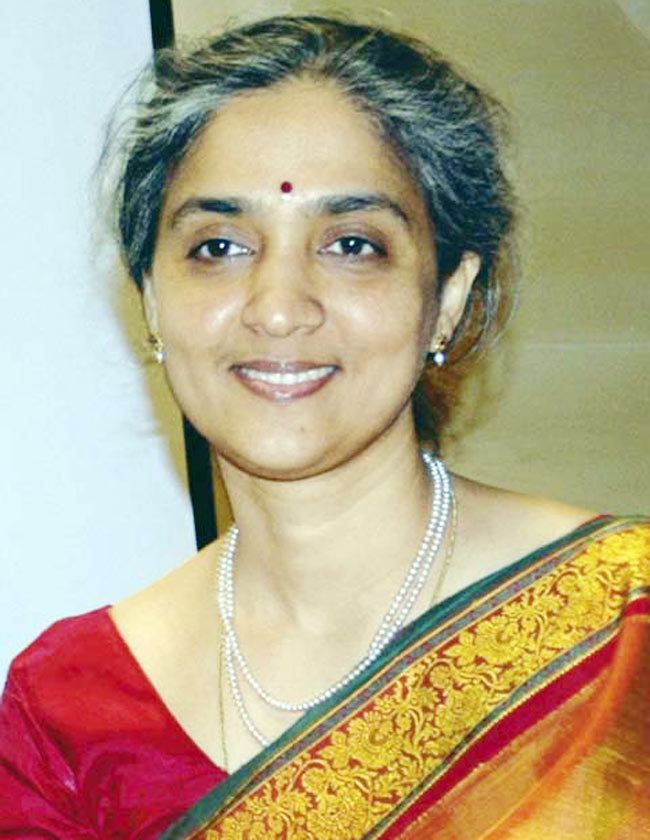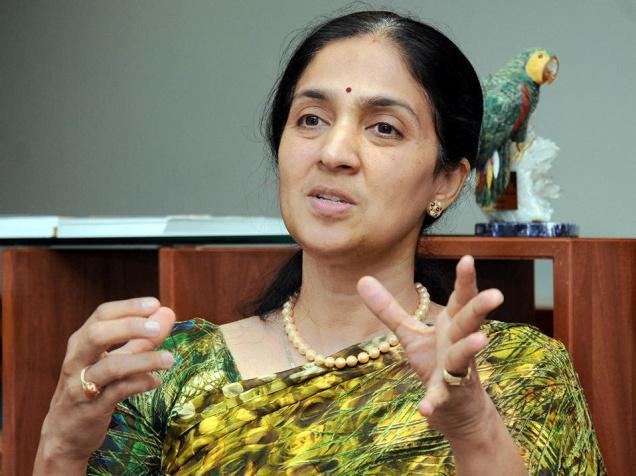Nationality Indian Education Bachelor of Commerce Role Executive | Name Chitra Ramkrishna Occupation Business executive Predecessor Ravi Narain | |
 | ||
Similar People Naina Lal Kidwai, Shikha Sharma, Mallika Srinivasan, Aruna Jayanthi, Chanda Kochhar | ||
Bbc world news interviews chitra ramkrishna md ceo nse
Chitra Ramkrishna (born 1963) is the first and former woman managing director and chief executive officer of the National Stock Exchange (NSE), an institution founded in the early 1990s to reform the capital market in India, and now ranking as the world's largest exchange in cash market trades and as one of the top three exchanges in index and stock derivatives. As the MD and CEO, Ms. Ramkrishna has not only maintained the rich legacy of this great institution, but her tireless endeavour has ensured it has scaled new heights.
Contents
- Bbc world news interviews chitra ramkrishna md ceo nse
- Leadership lecture by ms chitra ramkrishna 2 4
- Early career
- Career with NSE
- Awards
- Interests outside of work
- References

Moreover, her professional career includes the following positions:


Leadership lecture by ms chitra ramkrishna 2 4
Early career
Starting out as a chartered accountant, her first brush with finance came in 1985 when she joined the project finance division of Industrial Development Bank of India (IDBI). Ramkrishna then had a stint at Securities and Exchange Board of India (SEBI) and returned to IDBI two years later. It was here that she honed her financial skills, working at the treasury and fixed income departments before coming into her own while marketing the trendsetting deep discount bonds.
Her talent was such that the late RH Patil, executive director of IDBI at the time, complimented the young Ramkrishna for her extraordinary work and her role in making the bond issue a success. “In a public sector organisation, a senior manager rarely had a conversation with his junior. What Dr Patil did was completely unheard of. I was inspired and motivated to push myself further. Dr Patil was a visionary and a thinker and never seeded any doubts in our minds,” Ramkrishna says of the man who is widely credited with creating NSE.
Not surprising, she soon found herself as one of the five handpicked by the late SS Nadkarni, who was then IDBI chairman, to set up NSE from scratch.
Career with NSE
The association of Ms. Ramkrishna with the NSE dates back to the formative years when deliberations were on to create a modern stock exchange with a national presence. She was part of a hand-picked leadership team created to set up the NSE to provide a fully automated, screen-based trading system. Strong leadership qualities, a deep understanding of the market and a zeal for change enabled her to create an institution that has remained a watershed and a source of pride for the country in the international arena.
Ms. Ramkrishna has been associated with matters pertaining to market regulation and policy making even before the NSE was set up: an association that helped her take up the new responsibility with confidence. In the late 1980s, Ms. Ramkrishna was closely involved in the drafting of the legislative framework of the Securities and Exchange Board of India (SEBI), the country's capital market regulator. Even today, she continues to be a part of several SEBI committees on different policy issues such as the Secondary Market Advisory Committee and the Committee on Disclosures and Accounting Standards.
Over the years, captains of the financial and the corporate sector in India has increasingly recognised Ramkrishna as an institution builder and a thought leader. She is actively engaged in many important industry-body committees such as the CII's National Council on Financial Sector Development, FICCI's National Executive Committee and Capital Markets Committee, which provides her the opportunity to share her experience and knowledge and to closely interact with members from the industry.
A chartered accountant from the Institute of Chartered Accountants of India, she is the third woman to head an Exchange in the Asia-Pacific region after Sri Lanka's Colombo Stock Exchange and China's Shenzen Stock Exchange.
Her achievements have drawn appreciation from India and abroad, and she has received awards and accolades from various organisations. She was selected as the woman of the year in the Business Leadership Awards by the Forbes magazine recently and was also ranked 17th in the list of top global women business leaders by Fortune magazine, USA. She is the second most powerful businesswoman in India in this list. She has been featured in the list of top 30 women achievers by the Business Today group for the last four successive years.
Ms. Ramkrishna has undertaken several key initiatives at the NSE that has had far-reaching impact and ensured the exchange remained India's most premier bourse. She was instrumental in setting up a pan-India VSAT network and building the infrastructure and legislative framework for India's first depositor. She is also credited with facilitating screen-based trading, providing trading access to retail investors even in remote corners of the country, ensuring continuous cost leadership and creating a technological backbone that is scalable and unassailable.
Under her watch, NSE has launched products to suit all classes of investors, including futures and options, exchange traded funds, global indices like S&P 500. Recently, NSE introduced a dedicated debt platform to encourage retail investors and institutions to trade in corporate bonds.
Ramkrishna has invested considerable time and energy in making CNX Nifty 50 a global brand: today Nifty ETF’s are being traded in 15 prominent international exchanges. Nifty derivatives are also being traded on the Singapore Stock Exchange and Chicago Mercantile Exchange and will be trading soon on a derivative platform of the London Stock Exchange and the Osaka Securities Exchange.
Ramkrishna is evangelical about her second mission: to make the exchange a vehicle for the financial well-being of people in India. This she has done by introducing a combination of products that retail investors find easy and simple to use, and by spreading investor awareness through education.
Ramkrisha, one of the four Indians on the Fortune list of 50 most powerful business women in the world, has been part of NSE ever since its inception.
Under her, the NSE has become a transparent market ecosystem that reaches out to more than 1,500 locations in the country. Now the board is banking on her twenty years of experience to oversee India’s largest exchange—7th largest in the world—with a total listed market capitalisation of some $1 trillion.
Awards
Forbes' Women Leader of the year (2013): For striking a delicate balance between the exchange’s commercial and regulatory roles and keeping NSE ahead of the pack with a high degree of professionalism, new products and cutting-edge technology."
Interests outside of work
Carnatic music; likes to play the veena.
